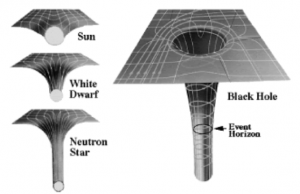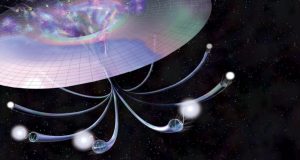Schwarzschild Cosmology and Black Hole-ception!
Written by: Laya Gopalakrishnan
1 x 10-43 seconds. This is the duration of time that our universe was able to remain within a 1 x 10-33 centimeter confine. Following this was a phenomenon that many of us are familiar with: The Big Bang. There are many theories regarding the origins of the Big Bang, one of the more astounding ones being that the singularity from which our universe expanded was that of a black hole. According to this theory, our universe is the product of the expansion of a black hole in a “parent universe”. If proven true, this would mean that universes are layered within universes, and that it is possible to travel through black holes into entirely new universes. Whether one would survive this journey is dangerously unlikely, but the possibility still stands! This theory is called Schwarzschild Cosmology.
Deep and Dark and Dangerous
The black hole is quite a terrifying cosmological entity. They are invisible, distinguishable only by the warping of matter around their event horizons, and have the strongest gravitational pull in the known universe. Not even light can escape their grasp. It is still debated whether or not black holes can be everlasting, a war between the classical theory of relativity and quantum mechanics, but in either scenario, they are just as disconcerting.
The anatomy of a black hole can be broken down into seven main portions. Forming the outermost “barrier” of the black hole is the accretion disc – a superheated mass of gas, stardust, plasma, and other particles, orbiting the black hole. The term accretion, as used in astrophysics, is the converging of matter to form larger entities. Thus, we know that accretion discs are the driving forces behind a black hole’s release of quasars – spiraling gas turrets originating from what is perceived as the entity’s “center” – and X-rays. Along the inside rim of the accretion disc lies the innermost stable orbit. As the name may suggest, it is the closest that matter can orbit a black hole without being drawn past the event horizon – more popularly known as the “point of no return.” The photon sphere and relativistic disk are similar in characteristics – both being forms of fast moving particles, light or radioactivity respectively, that are manipulated by the warped gravity of a black hole. The final part of a black hole is the singularity. All matter and energy that is drawn into a black hole is collapsed into this singular, infinitely dense point in space-time.
There are several types of black holes that exist in our known universe. Based on mass alone there are Primordial Black Holes, Stellar Mass Black Holes, Intermediate Mass Black Holes, and Supermassive Black holes. Black holes can also be classified based on their rotation and charge. According to german physicist Karl Schwarzschild, non-rotating black holes with neutral charges are created when the radius of an entity in space is smaller than a theoretical number assigned to it called the Schwarzschild Radius. This number can be calculated using the following formula, where r is the radius of a black hole’s event horizon, G is the gravitational constant, M is the black hole’s mass, and c is the speed of light:
![]()
These black holes are known as Schwarzschild Black Holes. Kerr Black Holes, more commonly found in space, have neutral charge but measurable rotation. Finally, there are Charged Black Holes, which have an electric charge assigned to them and can either be non-rotating or rotating.
Figure 1

Black holes are often modeled as spherical entities surrounded by orbiting gas clouds. It is important to remember and visualize a black hole as a “sink hole” within space-time.
Source: [NASA Goddard Space Flight Center]
Similarities Lie in the Singularities
The Big Bang being the expansion of the universe from a 1 x 10-33 centimeter point is similar to the incredibly dense “core” of a black hole. But what if this infinitely dense singularity was not so infinite after all? What if instead of culminating in a definitive point in space time, these singularities began expanding within the seemingly “bottomless” black holes themselves.
During an interview with National Geographic Magazine, Dr. Nikodem Poplawski from the University of New Haven points out that not only are infinities rarely found in nature, they are improbable. It is far more likely that black holes empty into an incredibly dense point, upon which they create a “seed” to a new universe.
Most importantly, it has recently been proven that the behaviour of spatial properties from and beyond the event horizon of a black hole, are identical to those from the event horizon down to the black hole’s singularity. And we know that a constant state of expansion preceded the Big Bang, a driving force allowing our universe to expand to what exists in our universe today. So it is entirely plausible that our universe stems from a supermassive black hole in a parent universe, and that supermassive black holes in our universe lead to new universes, and that we live in a multiversal reality, where universes lie within others. This itself opens a gateway of possibilities, a new approach to proving the all-too-sought-after multiverse theory.
Though our favorite Sci-Fi novels may be incorrect to assume the ease of travel from universe to universe , the existence of this reality leads to new horizons of knowledge. Scientists may finally be able to research the origins of our universe by studying those being created in black holes within our galaxy. Additionally, scientists may be able to trace back through parent universes in space-time, creating a line of ancestry.
Figure 2

It is possible that black holes may expand within themselves, creating untravelable “portals” to new universes.
Source: [Forbes]
Conclusion
Black holes are one of many fascinating astronomical entities in our known universe, but some of the properties that make them so abstruse may not be irrational after all. It is possible, even likely, that the singularities of black holes are the sources of universal expansion. Infact, it is possible that they are the culprits behind our Big Bang, and others, and the cause behind the existence of universes within universes. Though this would likely be an inefficient method of inter-universal travel, these ideas of universe-originating-singularities and black hole cosmology lead scientists closer to finding the origins of our universe. Additionally, we near the story behind origins of our parent universe and the origins of the first universe to occupy space time.
References and Sources
The Big Bang model of the Universe. . (2021). Retrieved 16 October 2021, from https://astronomy.swin.edu.au/~gmackie/BigBang/universe.htm
Curious Kids: can Earth be affected by a black hole in the future?. (2019). Retrieved 16 October 2021, from https://theconversation.com/curious-kids-can-earth-be-affected-by-a-black-hole-in-the-future-118181
Accretion disk | astronomy. (2021). Retrieved 16 October 2021, from https://www.britannica.com/science/accretion-disk
European Southern Observatory. (2019). Anatomy of a Black Hole. European Southern Observatory. Retrieved October 16, 2021, from https://www.eso.org/public/images/eso1907h/.
HubbleSite: Black Holes: Gravity’s Relentless Pull interactive: Encyclopedia. (2021). Retrieved 16 October 2021, from https://www.stsci.edu/~marel/black_holes/encyc_mod3_q2.html
Quasars: Brightest Objects in the Universe. (2018). Retrieved 16 October 2021, from https://www.space.com/17262-quasar-definition.html
quasar | astronomy. (2021). Retrieved 16 October 2021, from https://www.britannica.com/science/quasar
Schwarzschild Radius | COSMOS. (2021). Retrieved 16 October 2021, from https://astronomy.swin.edu.au/cosmos/S/Schwarzschild+Radius
Explore Karl Schwarzschild’s point of no return and the event horizons. (2021). Retrieved 16 October 2021, from https://www.britannica.com/video/186453/Karl-Schwarzschild-work-event-horizons-radius
Black Hole | COSMOS. (2021). Retrieved 16 October 2021, from https://astronomy.swin.edu.au/cosmos/b/black+hole
Siegel, E. (2021). Did A Black Hole Give Birth To Our Universe?. Retrieved 16 October 2021, from https://www.forbes.com/sites/startswithabang/2020/11/03/did-a-black-hole-give-birth-to-our-universe/?sh=34973cfa50da
Black Holes, Explained. (2021). Retrieved 16 October 2021, from https://www.nationalgeographic.com/science/article/black-holes
Are We Living in a Black Hole?. (2021). Retrieved 16 October 2021, from https://www.nationalgeographic.com/science/article/140218-black-hole-blast-explains-big-bang
1 thoughts on “Schwarzschild Cosmology and Black Hole-ception!”